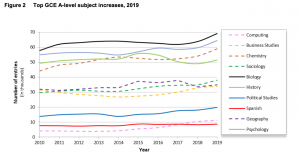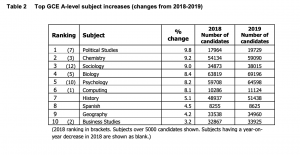Oxford celebrates its «valuable relationship» with Instituto Cervantes in the 50th anniversary of the Spanish Faculty
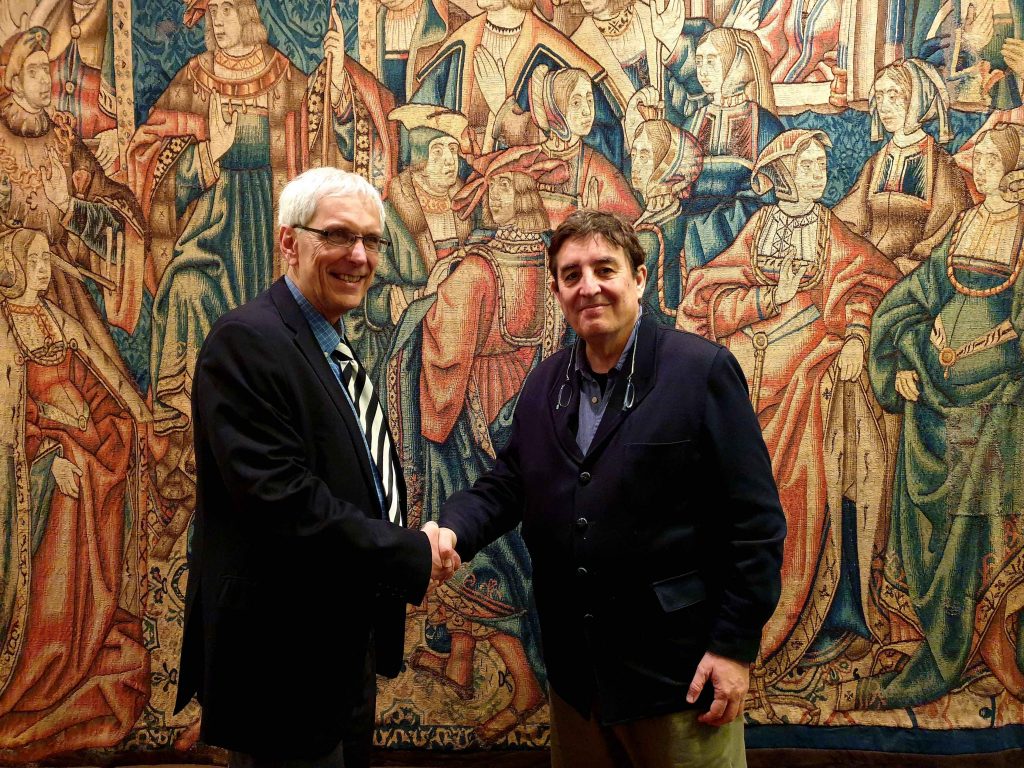
The director of Instituto Cervantes, Luis García Montero, attended today the 50th anniversary celebrations of the Spanish and Portuguese Sub-Faculty at the University of Oxford. Tomorrow, he will sign a memorandum of understanding (MOU) with Magdalen College.
“The participation of Instituto Cervantes in this commemoration is due to the fact that our relationship is very valuable,” said Jonathan Thacker, Professor Alfonso XIII of Spanish studies at Oxford, who explained that although Spanish has been taught at this university for more 100 years, only now does he feel that «it is a really vibrant language».
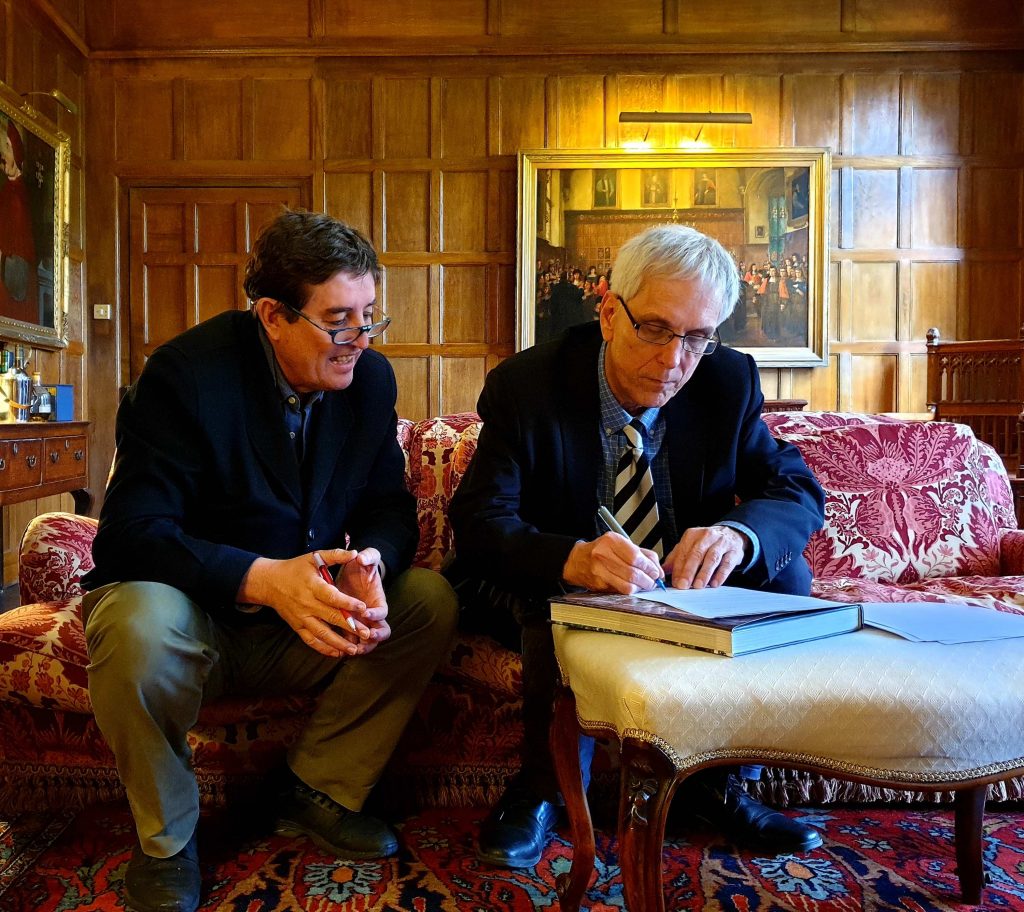
Expert in the Spanish Golden Age, Professor Thacker said that García Montero’s assistance “is not only because he is the director of a very important cultural institution, but also an academic and a poet, producing a type of literature that we teach in Oxford. We wanted this celebration to be a combination of academic content and more vivid content.” Alongside the celebration, there were poetry readings by García Montero himself and Portuguese writer Ana Luísa Amaral to enliven and complement the anniversary.
Memorandum of Understanding with Magdalen College
“This agreement is a recognition of a trajectory that has been underway for a few years and the consolidation of a future collaboration that I wish to be very long. It is about putting in black and white what has been developing for a long time, especially in these last two years,” said the professor of Spanish Medieval Literature and Philology at the University of Oxford, Juan Carlos Conde.
For Conde, the signing of this memorandum is to give, «a naturalisation certificate and secure it for the future.” In fact, it is clear that the presence of Spanish in Oxford is strengthened with two initiatives mentioned in the MOU: the Madariaga Series and the Magdalen Iberian Medieval Studies Seminar (MIMSS).
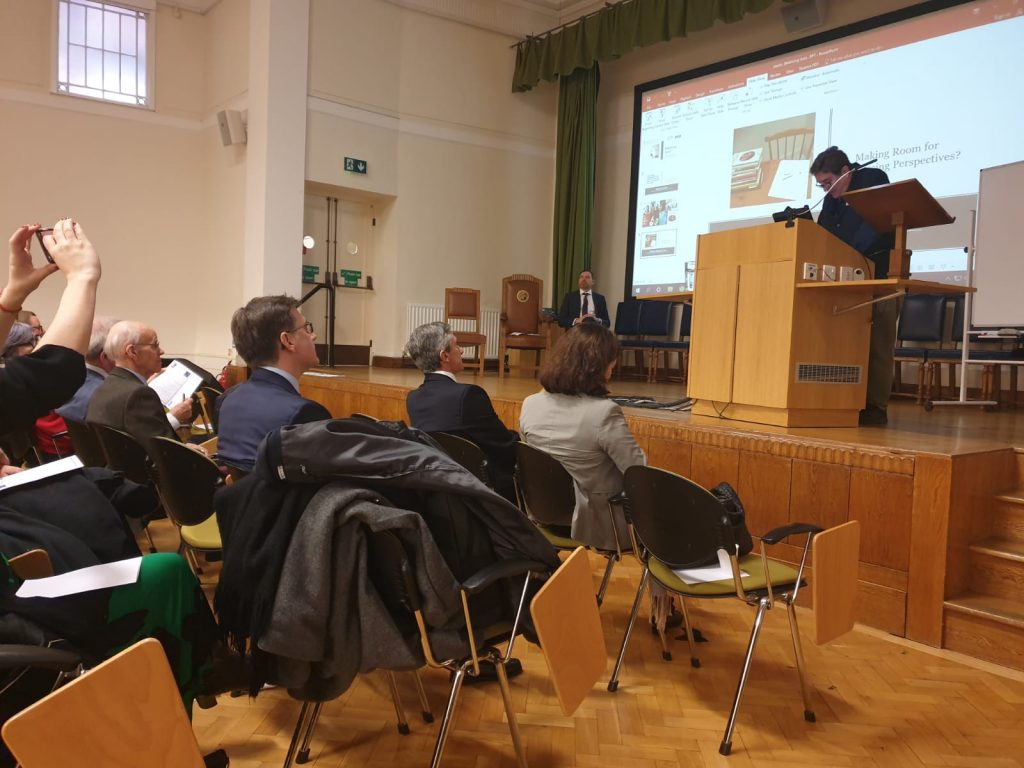
The Madariaga Series is the result of an initiative by a group of postgraduate students at the end of year 2014. Among the first guests in 2015 were figures such as Miguel Ángel Moratinos and Javier Solana. One of the students behind the initiative, Diego Rubio, approached Conde to ask whether Magdalen College could give the series voice and visibility in Oxford. A few months later, they successfully gave the Madariaga Series a “home, roof and shelter, as well as a significant economic contribution.» In the case of the MIMSS cycle, it is the most important medieval studies seminar in the United Kingdom today.
“I want to believe that these activities, in parallel to teaching and training, will contribute to the experience of current and future Oxford students, providing them with a series of opportunities they don’t have in other places,” said Conde.
Spanish students in Oxford
“For undergraduate students who want to study here, they must have previously studied Spanish up to A-levels exams. We have an average of between 300 and 320 students who request to study here and we accept between 70 and 75, that is, one in four students. I think this is a sign of the good health of teaching Spanish in schools,” said Professor Thacker.

Twenty years ago, when this professor began working at Oxford, there was an average of approximately 150 applicants for 40 positions. «We have grown a lot, but the big difference is that there are more applications for Modern Languages, because when students apply to study here, they have to choose that route and then specify if they want Russian, Italian, Spanish or what language,» he pointed out.
While interest in French and German is going down, Spanish has broken that trend, and at the moment, there is still a good level of applicants: “I hope it is because they like the level of our course, but also because there are a lot of young people here interested in Hispanic culture and Spanish history, and want to travel and like to travel to countries where Spanish is spoken. ”
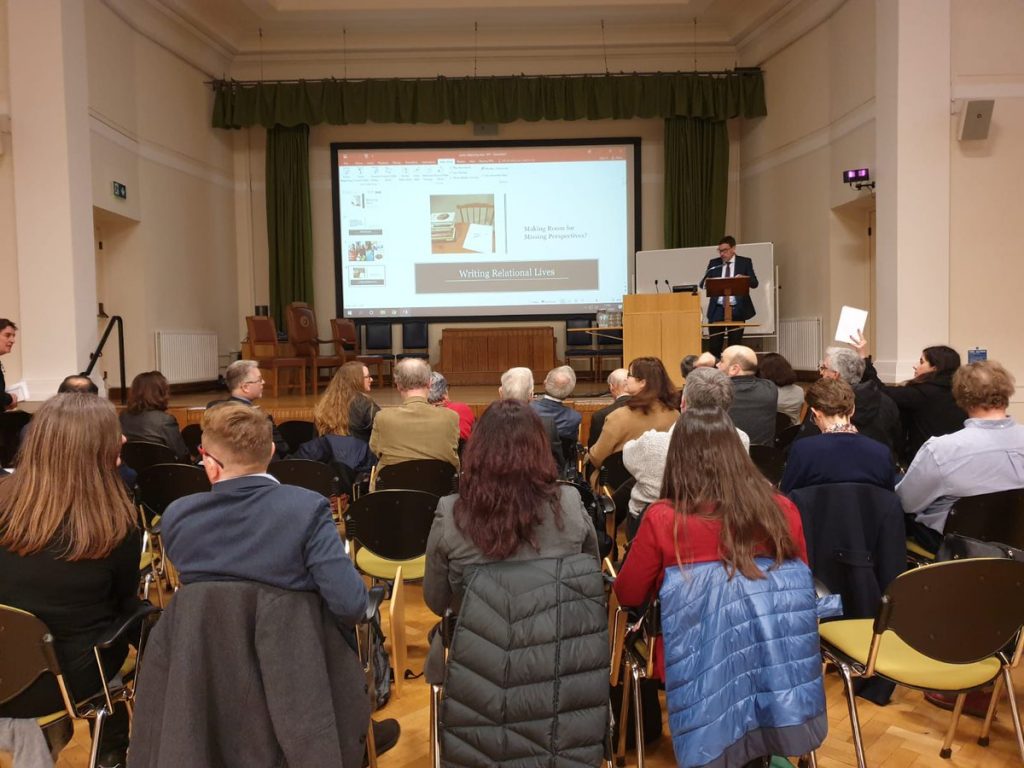
Future of the Spanish language
Thacker would like to continue seeing Spanish growing in the coming years and that the Sub-Faculty of Medieval and Modern Languages at the University of Oxford is able to accept all good applicants for Spanish studies, both undergraduate and graduate. Alongside this growth is also an impetus on always maintaining the current level of interdisciplinary interaction and with other Sub-Faculties in Oxford that there are today.
Spain recognises the work of the great British historian, Paul Preston

The British historian and Hispanist Sir Paul Preston (Liverpool, 1946) will make an announcement in London on February 28th, that he has chosen to leave a copy of the first book he published in the Caja de las Letras, Instituto Cervantes’ headquarters in Madrid.
The Caja de las Letras is a vault of safe-deposit boxes in a former bank building that has been repurposed as a time capsule for Hispanic culture. Many Spanish artists and thinkers have been invited to leave an artifact of their choosing in the security boxes, along with the date the safe should be reopened.
In the case of Sir Paul Preston, he has chosen a book based on his thesis, The Destruction of Democracy in Spain (1978) which contains notes written by Hispanist Sir Raymond Carr. The first box ever used was Number 1,000 and was filled by writer Francisco Ayala in 2007. And for the first time in the history of the boxes, Preston’s donation is going to be done away from Madrid.
As Sir Paul Preston suffers from specific health problems that prevent him from travelling to Spain, his donated book will be taken to Madrid in a red briefcase guarded by the director of Instituto Cervantes, Luis García Montero.
«It is a great honor to join the Caja de las Letras, especially when it seems that there are very few writers who are not Spanish-speaking, and that has moved me,» said the British historian, who chose to open his box in five years time.
The text, a documented study that traces the origins of the Spanish Civil War, was started from the doctoral thesis that he presented at the University of Oxford about the monarchical conspiracies against the Spanish Republic. It is a copy much valued by Sir Paul Preston because of the annotations from his teacher, British historian and Hispanist Sir Raymond Carr (1919-2015).
“If you leave an object without further ado, for me it does not have much interest for those who open the Caja de las Letras in the future. That is why I thought that if someone interested in my work opens it, this has twice the interest, since it is my book and is annotated by Raymond Carr. In addition, this copy arrived to me in a very strange way: a friend found it in a second-hand bookshop and then he gave it to me,” explained Sir Paul Preston.
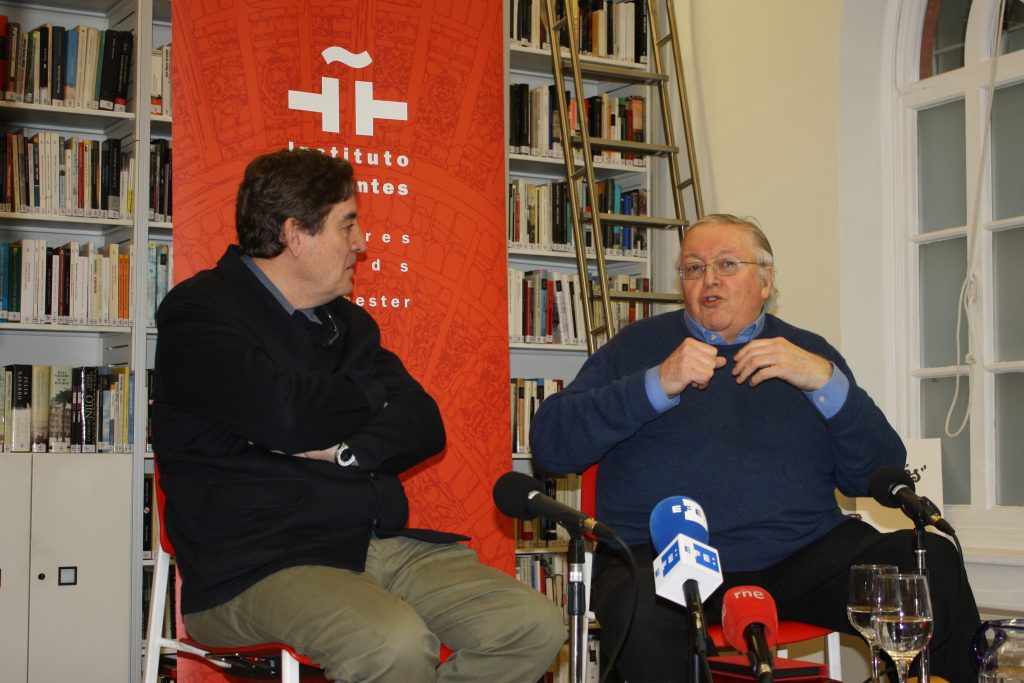
Disciple of Hugh Thomas
Sir Paul Preston’s childhood was spent in a working-class neighborhood of Liverpool, a city heavily punished by German bombing during World War II, as it was the port that received food and weapons shipments from the United States.
«I was born just after the War, but in my childhood the conversations of adults were very much about the bombings and the blitz, which came from the German expression blitzkrieg, quick war.» Very soon those stories became my favorite readings when I reached adolescence and I began to be interested in reading, above all, about the origins of World War II,” said the British historian.
Sir Paul Preston considered that he had «really incredible luck» for a working-class boy and from the North in being able to study History at Oxford University. «It was a small miracle and I was hoping, but among the subjects there were few which really impassioned me: almost everything was Constitutional History,» he added.
At the end of the race, and «wanting more», Sir Paul Preston again had «immense luck» when he was offered a scholarship to a postgraduate course on the period of Entreguerras (1918- 1939) at the University of Reading. “One of the subjects, the one that dealt with the Spanish Civil War, was given by Hugh Thomas. There I started teaching with him and everything fascinated me.”
From that moment, Sir Paul Preston began to «eat books» and read everything in English about the Spanish Civil War, realising that it was the perfect topic for his doctoral research: «It was a pandora box in which there was everything, fascism, communism, socialism, Freemasonry and great international figures (Stalin, Hitler, Trotsky…), etc.”
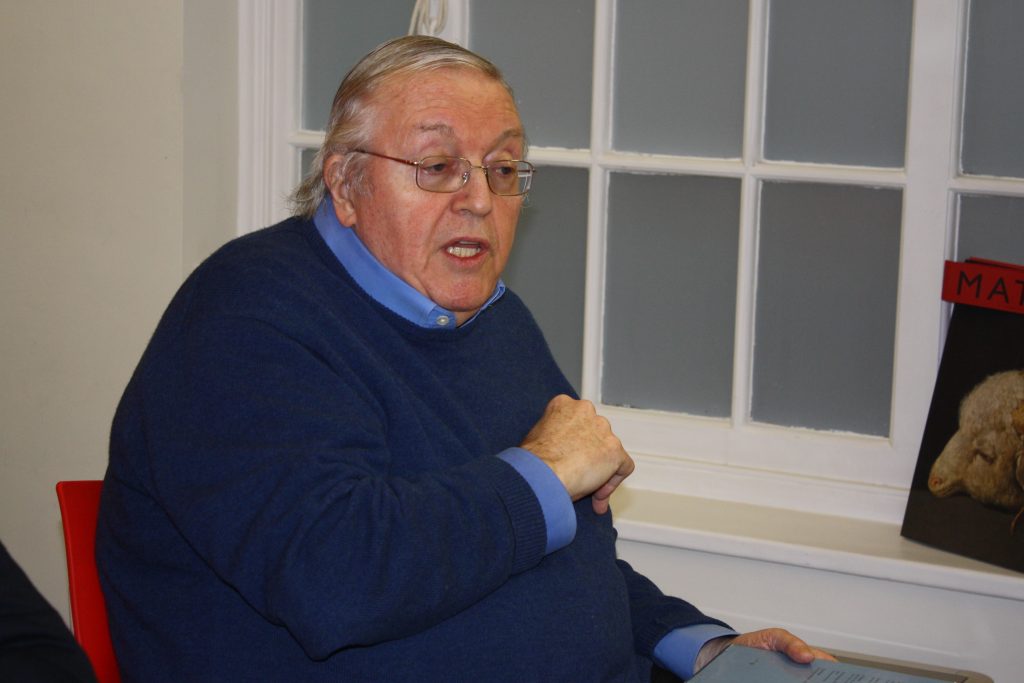
First trip to Spain
It was at that time that Sir Paul Preston decided that he «had to learn Spanish» and began to practice it with Colombian students in the cafeteria of the University. He traveled to Spain for the first time in the late 60s: “It was a great crush because Spain at that time had little to do with Spain today. I remember walking the streets of Madrid, the smells of food and the work of artisans.”
Sir Paul Preston acknowledged that he felt in love with Spain and was very excited with “the welcome that people gave me, I don’t know if it is like that now, but for someone who only babbled a couple of words in Spanish, people were very warm and they loved to see you and try to improve your Spanish, quite the opposite than in other countries.”
A life dedicated to the study of the History of Spain
Sir Paul Preston is a Doctor in History at the University of Oxford. He is a member of the British Academy and director of the Canada Blanch Centre of the London School of Economics, where he was Professor of International History for many years. Preston enjoys global fame as one of the greatest experts in the Spanish Civil War. He is also the author of reference biographies for Franco and Juan Carlos I.
Specialist in contemporary Spain, the historian has received the Commendation of the Order of Civil Merit and the Grand Cross of the Order of Isabel la Católica. Among his most outstanding works are Revolution and War in Spain 1931-1939 (1986); The Spanish Civil War (1987); Franco, leader of Spain (1994); Juan Carlos I (2003); The Spanish Holocaust (2011); the biography of Santiago Carrillo The red fox (2013), and his most recent and monumental work, A betrayed people: Spain from 1876 to the present day: Corruption, political incompetence and social division (2019).

First artifact in La Caja de las Letras made from a distance
The artifact left by Sir Paul Preston is the first one that is made from a distance in the history of Instituto Cervantes. The book donated by the great British historian will travel in a red briefcase guarded by the director of the Spanish institution, Luis García Montero.
With the delivery of his legacy, Sir Paul Preston joins another Hispanist historian Sir John Elliott, the first native non-Spanish speaker invited by Instituto Cervantes to the former vault of its headquarters in October 2017. This month, Irish Hispanist Ian Gibson joined him, choosing to leave as a legacy two books by Gerald Brenan.
The Caja de las Letras celebrated its first decade in 2018 as a time capsule that keeps legacies ceded by cultural personalities in Spanish. Writers, artists, musicians, scientists, filmmakers or actors have left locked-up personal objects that are witnesses and memories of their life trajectory in the former vault of the Instituto Cervantes’ headquarters.
Throughout these years, prominent protagonists of the culture of Spain and Latin America have deposited their legacies in one of the 1,800 safety boxes located in the building known as the Cariátide, in the centre of Madrid. Through their basements, all the writers awarded the Cervantes Prize in the last two decades have passed: Antonio Gamoneda, Juan Gelman, Ana María Matute, Juan Marsé, José Emilio Pacheco, José Manuel Caballero Bonald, Nicanor Parra, Elena Poniatowska, Juan Goytisolo, Fernando del Paso and Eduardo Mendoza.
Narrator and essayist Francisco Ayala, Cervantes Prize 1991, was the one who inaugurated the Caja de las Letras in February 2007 with a secret legacy in box number 2,000. Since then, other illustrious authors in addition to those mentioned, such as Carlos Edmundo de Ory, Pablo García Baena or Jorge Edwards, have left their mark in this peculiar enclave where customers formerly deposited jewels and treasure.
Although writers make up the majority of the boxes (almost twenty), many other expressions of culture are also represented: art (Antoni Tàpies), science (Margarita Salas), music (Cristóbal Halffter, Luis de Pablo), dance (Alicia Alonso, Víctor Ullate), cinema (Luis García Berlanga), theatre (Nuria Espert), interpretation (Manuel Alexandre), photography and edition (Mario Muchnik) or literary management (Carmen Balcells).
The boxes each have a specific opening date, chosen by each guest. There is only one exception: composer Luis de Pablo asked that his safe be opened when he dies (therefore, it is not known when) and that in the same act the unpublished score that he left saved there must be read. So far, three boxes have been reopened: those of the literary agent Carmen Balcells, actor Manuel Alexandre and molecular biologist Margarita Salas.
Among other objects, it is worth mentioning the typewriter of the recently deceased Nicanor Parra, who ceded his grandson in 2012, since the Chilean poet, who was then 97 years old, could not come to Spain to collect the Cervantes prize.
Legacies in memoriam
The Caja de las Letras also keeps four legacies in memoriam, that is, personalities already deceased. Colombian Nobel laureate Gabriel García Márquez retains a box with land from his home in Aracataca. Antonio Buero Vallejo, his pipe and one of the pens with which he wrote the plays. From writer Miguel Hernández, a first edition of his earliest poems, Perito en lunas (1933). And from Argentine singer Atahualpa Yupanqui, handwritten postcards sent to his wife during his trips.
Instituto Cervantes participates in The Language Show 2019 in London

Instituto Cervantes in London will participate in the Language Show on the 15-17th November. Hosted in London annually, it encourages learning and improvement across all global languages in colleges and universities, including range of official exams qualifications. There will also be cultural events held in celebration of nations across the United Kingdom.
«The Language Show is a unique opportunity to have direct contact with the language teaching offer available in the UK. To Instituto Cervantes in London, it is the best showcase to promote the center in the country,» underlines the head of studies at Instituto Cervantes in London, Pablo Martínez Gila.

In addition, Martínez Gila highlights the high number of Spanish teachers who approach the stand to learn about the possibilities of training in Spanish as a Foreign Language (ELE), in order to update didactic, methodological and linguistic knowledge.
In its 31st edition, The Language Show is considered the largest language event in Europe, offering outstanding talks, classes and functions including over 100 exhibitors as well as test classes in 23 languages, free lectures and seminars.
The Cervantes Institute will have a joint stand with the Consejería de Educación and the Embassy of Spain in London, in which it will show the academic offer (classes and training), cultural centre and library.

The event takes place in the Olympia fairgrounds, and it’s an opportunity that cannot be missed for anyone learning or teaching a language. The wealth of resources on offer as well as help, advice, ways to learn and teach is unprecedented and, most importantly, will be an inspiration to all those who attend.
Get your free ticket to go to The Language Show here.
Spanish, a language spoken by 580 million people, and 483 million of them native
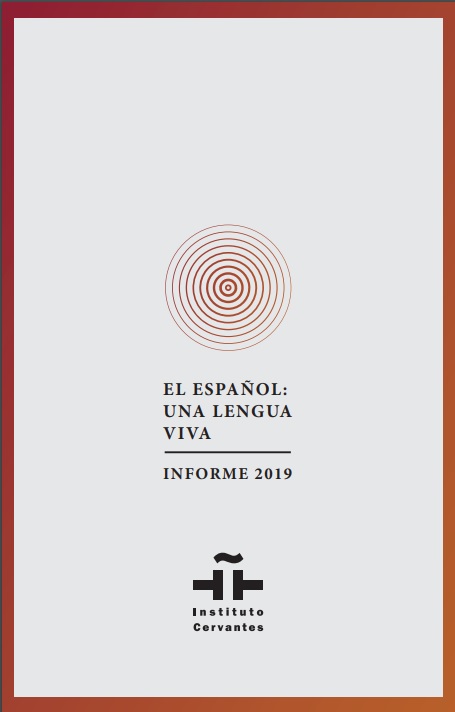
A total of 580 million people speak Spanish in the world, 7.6% of the world’s population. Of these, 483 million – three million more than a year ago – are native Spanish speakers, which makes Spanish the world’s second mother tongue by number of speakers. In addition, studies have shown that these 22 million people span across 110 countries. Spanish is the third most used language on the internet, where it has great growth potential.
Which is unfortunate, montreal online casino bids 100 Bonus Spins for the game Book of Dead from Playn GO are included in this welcome offer!
These are some of the most relevant data collected by the “Yearbook of Spanish in the world 2019”, done by Instituto Cervantes, presented by its director, Luis García Montero, accompanied by people who were in charge for its content, in an event open to the public.
David Fernández Vítores, author of the study, believes that Brexit will be positive for Spanish in the European Union because it will increase the proportion of Spanish speakers. His 90-page study offers an updated and very reliable census of Spanish speakers and contains «very positive and innovative data», such as the importance given to Spanish in the Linkedin network, a space that is analyzed here for the first time .
The first section of the book introduces the updated data on the Spanish language in areas such as demography, teaching and learning, Internet and social networks, science and culture, its international influence and economic value, as well as its diplomatic presence.
Demography:
Almost 483 million people have Spanish as their mother tongue. (The 2018 Yearbook estimated native speakers at 480 million).
The number of potential Spanish users exceeds 580 million. This figure brings together the groups of native domain, limited competence and foreign language students. Last year it was 577 million.
Spanish is the second mother tongue in the world by number of speakers, only behind Mandarin Chinese.
It is the third language in the global computation of speakers (native domain + limited proficiency + Spanish students) after English and Chinese.
7.6% of the world’s population is today Spanish-speaking. The percentage is expected to increase one tenth (7.7%) in 2050.
In 2100, this percentage is expected to fall to 6.6%, mainly due to the decline in inhabitants of Latin America in the face of the population explosion in several African countries, among other factors.
For demographic reasons, the percentage of the world’s population that speaks Spanish as a native language is increasing, while the proportion of Chinese, English and French speakers decreases.
In 2060, The United States is anticipated to be the second Spanish-speaking country in the world after Mexico: almost one in three Americans will be Hispanic.
Study of Spanish as a foreign language:
A total of 21,882,448 students study Spanish as a foreign language (67,000 more than last year), according to data recorded in 110 countries and at all levels of education.
The Cervantes Institute estimates that the real demand is 25% higher, since the data does not also reflect private education.
In the US, Spanish is the most studied language at all levels of education.
In the United Kingdom, Spanish is perceived as the most important language for the future.
In the European Union, France, Italy, United Kingdom and Germany (in this order) are the countries with the highest number of Spanish students.
The teaching of Spanish in English-speaking countries such as Canada (with 90,000 students), Ireland (47,000), Australia (34,000) and New Zealand (36,000) has also grown significantly.
Economy:
The contribution of all Spanish-speaking countries to global GDP (Gross Domestic Product) is 6.9%. A higher percentage than that generated by countries that have French as their official language.
In the case of Spanish, the common language multiplies by four bilateral exports among Spanish-speaking countries.
Spanish would be the fourth most powerful language in the world, slightly behind French and Chinese, and a great distance from English.
Spanish occupies the third position in the UN (United Nations Organization) and fourth in the scope of the European Union.
Spanish on the Internet:
It is the third most used language on the Internet after English and Chinese.
8.1% of internet communication occurs in Spanish.
It is the second most used language on Wikipedia, Facebook, Twitter and Linkedin. Of the 580 users of the Linkedin social network, 55 million use Spanish to a greater or lesser extent. Most of them (43 million), in Central and South America.
Spanish has a high potential for growth on the Internet due to the average internet availability in Spanish-speaking countries (which is 65.8%, still far from penetration in Spain, which exceeds 92%).
Mexico is among the ten countries with the highest number of users on the Internet.
Spanish in science and culture:
After English, Spanish is the second language in which most scientific documents are published.
Although the participation of Spanish-speaking countries in world scientific production has grown since 1996, Spanish scientific and technical research is relegated to a secondary level in the international arena.
Publishing Market:
Spain is the third largest exporter of books in the world, after the United Kingdom and the United States.
Two Spanish-speaking countries – Spain and Argentina – are among the top 15 book producers in the world, according to the International Publishers Association.
Spain occupies the eighth place in book production, and the ninth in the market value of the publishing sector.
Although the publication of books in electronic format is increasingly widespread, its market share is still low in Spanish-speaking countries.
READ THE FULL REPORT: «Yearbook of Spanish in the world 2019»
El español, una lengua que hablan 580 millones de personas, 483 millones de ellos nativos

Un total de 580 millones de personas hablan español en el mundo, el 7,6% de la población mundial. De ellos, 483 millones –tres millones más que hace un año– son hispanohablantes nativos, lo que convierte al español en la segunda lengua materna del mundo por número de hablantes. Además, lo estudian casi 22 millones de personas en 110 países. El español es la tercera lengua más utilizada en internet, donde tiene un gran potencial de crecimiento.
Son algunos de los datos más relevantes que recoge el Anuario El español en el mundo 2019 del Instituto Cervantes, que este mediodía presentó su director, Luis García Montero, acompañado por otros responsables de su contenido, en un acto abierto al público que clausuró la vicepresidenta del Gobierno en funciones, Carmen Calvo.
David Fernández Vítores, autor del estudio El español: una lengua viva. Informe 2019, cree que el brexit será positivo para el español en la Unión Europea porque hará aumentar la proporción de hispanohablantes. Su estudio, de 90 páginas, ofrece un censo actualizado y muy fiable de los hablantes de español y contiene «datos muy positivos y novedosos», como la importancia que se da al español en la red Linkedin, un espacio que se analiza por primera vez.
La primera sección del libro, El español: una lengua viva. Informe 2019, presenta a lo largo de 90 páginas los datos actualizados sobre la lengua española en ámbitos como la demografía, enseñanza y aprendizaje, Internet y redes sociales, ciencia y cultura, su influencia internacional y valor económico, así como su presencia diplomática.
El informe destaca los siguientes datos relevantes:
Demografía:
- Casi 483 millones de personas tienen el español como lengua materna. (El Anuario 2018 cifraba los hablantes nativos en 480 millones).
- El número de usuarios potenciales de español supera los 580 millones. Esta cifra aglutina a los grupos de dominio nativo, de competencia limitada y estudiantes de lengua extranjera. El pasado año era de 577 millones.
- El español es la segunda lengua materna del mundo por número de hablantes, solo por detrás del chino mandarín.
- Es la tercera lengua en el cómputo global de hablantes (dominio nativo + competencia limitada + estudiantes de español) después del inglés y del chino.
- El 7,6% de la población mundial es hoy hispanohablante. Se prevé que el porcentaje aumente una décima (7,7%) en el año 2050.
- En 2100, este porcentaje bajará al 6,6 % debido fundamentalmente al descenso de habitantes de Hispanoamérica frente a la explosión demográfica en varios países africanos, entre otros factores.
- Por razones demográficas, el porcentaje de población mundial que habla español como lengua nativa está aumentando, mientras que la proporción de hablantes de chino, inglés y francés desciende. ·
- Estados Unidos será en 2060 el segundo país hispanohablante del mundo después de México: casi uno de cada tres estadounidenses será hispano.
Estudio del español como lengua extranjera:
- Un total de 21.882.448 alumnos estudian español como lengua extranjera (67.000 más que el año pasado), según datos referidos a 110 países y en todos los niveles de enseñanza.
- El Instituto Cervantes estima que la demanda real es un 25% mayor, ya que esos datos apenas reflejan la enseñanza privada.
- En EE. UU. el español es el idioma más estudiado en todos los niveles de enseñanza.
- En el Reino Unido, el español es percibido como la lengua más importante para el futuro.
- En la Unión Europea, Francia, Italia, Reino Unido y Alemania (por este orden) son los países con un mayor número de estudiantes de español.
- También ha crecido notablemente la enseñanza de español en países anglófonos como Canadá (con 90.000 estudiantes), Irlanda (47.000), Australia (34.000) y Nueva Zelanda (36.000).
Economía:
- La contribución del conjunto de los países hispanohablantes al PIB (Producto Interior Bruto) mundial es del 6,9 %. Un porcentaje superior al generado por los países que tienen el francés como lengua oficial.
- En el caso del español, la lengua común multiplica por cuatro las exportaciones bilaterales entre los países hispanohablantes.
- El español sería la cuarta lengua más poderosa del mundo, ligeramente detrás del francés y del chino, y a gran distancia del inglés.
- El español ocupa la tercera posición en la ONU (Organización de las Naciones Unidas) y la cuarta en el ámbito de la Unión Europea.
El español en Internet:
- Es la tercera lengua más utilizada en la Red después del inglés y del chino.
- El 8,1% de la comunicación en internet se produce en español. E
- Es la segunda lengua más utilizada en Wikipedia, Facebook, Twitter y Linkedin. De los 580 usuarios de la red social Linkedin, 55 millones utilizan en mayor o menor medida el español. La mayoría de ellos (43 millones), en Centroamérica y Sudamérica.
- El español tiene un alto potencial de crecimiento en Internet debido a la penetración media de internet en los países hispanohablantes (que es de un 65,8%, aún lejos de la penetración en España, que supera el 92%).
- México se encuentra entre los diez países con mayor número de usuarios en Internet.
El español en la ciencia y en la cultura:
- Después del inglés, el español es la segunda lengua en la que más documentos de carácter científico se publican.
- Aunque la participación de los países hispanohablantes en la producción científica mundial ha crecido desde 1996, el español científico y técnico se encuentra relegado a un plano secundario en el ámbito internacional.
Mercado editorial:
- España es el tercer país exportador de libros del mundo, después del Reino Unido y Estados Unidos.
- Dos países hispanohablantes –España y Argentina– se encuentran entre los 15 principales productores de libros del mundo, según la International Publishers Association.
- España ocupa el octavo puesto en producción de libros, y el noveno por valor de mercado del sector editorial.
- Aunque la publicación de libros en formato electrónico está cada vez más extendida, su cuota de mercado es aún escasa en los países de habla española.
Instituto Cervantes in London launches the Diploma of Teaching Accreditation (DADIC)
 For the first time, Instituto Cervantes in London will host the course to obtain the Diploma of Teaching Accreditation of Instituto Cervantes (DADIC) in October. This is an introductory teaching course aimed at people without previous experience or training in language teaching.
For the first time, Instituto Cervantes in London will host the course to obtain the Diploma of Teaching Accreditation of Instituto Cervantes (DADIC) in October. This is an introductory teaching course aimed at people without previous experience or training in language teaching.
This 140-hour course will have a 50% practical component and 50% theory. The course covers the first stage of development, including teaching competence and preparation for the teaching accreditation of Instituto Cervantes.
Institute Cervantes is undertaking the training of future teachers of Spanish through the Diploma of Teaching Accreditation. It’s the first of a series of diplomas that will accredit the different levels of pedagogical aptitude in the field of Spanish as a foreign language. To access the Diploma, teachers can take a course (which will be offered at the Institute’s headquarters in Alcalá de Henares, Madrid and in the Institute’s centers worldwide) or assessment tests are also available, dependent on the student’s level and experience.
The DADIC course is based primarily on teaching practices (class observation, teaching simulations, classes taught with real students at Instituto Cervantes, among others). It also involves reflection on these practices as tools to build the necessary knowledge to successfully and autonomously face the work of a Spanish teacher.
«Instituto Cervantes has undertaken the work of unifying the training of Spanish teachers of the future, and has begun to do so through the Diploma of Teaching Accreditation (Autonomous level), the first in a series of diplomas that will accredit different levels of pedagogical aptitude in the field of Spanish as a foreign language. To access the Diploma, teachers can take a course (which will be offered at the headquarters of the Institute in Alcalá de Henares and in the centers of the Institute in the world) or, if their training and experience a series of evaluation tests allows it,» explains Pablo Martínez Gila, head of studies at the Cervantes Institute in London.
Martínez emphasizes how the course to obtain the DADIC diploma will be based primarily on teaching practices (class observation, teaching simulations, classes taught with real students at Instituto Cervantes in London, etc.) and on the reflection on these practices as tools to go building the knowledge necessary to successfully and autonomously face the work of the Spanish teacher for foreigners.
For more information, visit our website
El cine en español protagoniza el mes de los festivales en Londres
El Instituto Cervantes de Londres cuenta con un programa cultural este mes de septiembre en el que destaca el apoyo a la presencia de películas y cineastas hispanohablantes en los festivales y salas más importantes de la capital británica (BFI, Open City Documentary Festival, LUX, Tate Modern, Institute of Contemporary Arts, London Spanish Film Festival y Raindance Film Festival).
“La vitalidad del cine en español es uno de los rasgos que definen el actual momento del cine en el mundo. Y un cine con vocación global, como es el nuestro, debe mostrarse en una capital global como es Londres”, afirma Ignacio Peyró, director del Instituto Cervantes en la capital británica.
Gracias al Instituto Cervantes, cineastas españoles e hispanoamericanos pueden formar parte de gran parte de festivales de prestigio celebrados en Londres, aumentando así la visibilidad de las producciones rodadas en España –sea en castellano o lenguas cooficiales- e Hispanoamérica, añade Peyró.
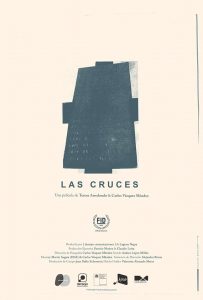
Las cruces (2018)
Open City Documentary Festival: Un misterio sin resolver 40 años
El mes comienza con la proyección del largometraje documental chileno Las cruces y el posterior coloquio con los directores Teresa Arredondo y Carlos Vásquez Méndez, el domingo 8 de septiembre a la 1:45 pm, dentro del programa del Open City Documentary Festival.
Este será el estreno de Las cruces en Reino Unido, que sitúa la acción solo unos días después del golpe militar de 1973 contra el gobierno de Allende en Chile, cuando un grupo de 19 miembros sindicales en una fábrica de papel desaparecieron sin dejar rastro.
El caso fue un misterio durante 40 años, hasta que un policía involucrado en la masacre finalmente rompió el pacto de silencio. Tomando su confesión junto con el testimonio de las familias de las víctimas, los cineastas descifran los eventos que condujeron a los asesinatos, usando fotografías de 16 mm para representar el paisaje como una escena del crimen.
LUX: Trabajos de artistas con sede en el Reino Unido

Reserve (Gerard Ortín Castellví, 2017-2019) y El paisaje está vacío y el vacío es paisaje (Carla Andrade, 2017)
El domingo 15 de septiembre a las 7:00 pm tiene lugar la proyección, con posterior coloquio, de los Nuevos trabajos de los directores Carla Andrade y Gerard Ortín, dentro del programa de LUX, la agencia de arte internacional que apoya las prácticas de imagen en movimiento de los artistas y las ideas que las rodean.
La viguesa Andrade y el barcelonés Castellví son graduados españoles del título de Cine de Artistas e Imagen en Movimiento en Goldsmiths, Universidad de Londres. Su trabajo está enfocado hacia conceptos paisajísticos. Mientras que Andrade se siente atraído por la naturaleza salvaje por su inalcanzabilidad e imposibilidad, el trabajo de Ortín problematiza la idea de la «naturaleza» en sí misma, en un imaginario no siempre enfocado hacia las ideas humanas de naturaleza.
Ambos trabajan a través de los medios de comunicación, con un enfoque en la imagen en movimiento. Dentro del contexto de la serie de proyecciones New Work en Lux, se proyectará una selección de obras recientes de ambos artistas seguida de una conversación entre ellos y María Palacios Cruz.
Berwick Film & Media Arts Festival 2019: Un diálogo entre culturas

Cemetery, film still (2019)
En el caso del cineasta barcelonés Carlos Casas presenta la película Cemetery, una inmersión total e hipnótica en la jungla, tras la pista del cementerio de elefantes, y participa acto seguido en un coloquio en la galería de arte contemporáneo Tate Modern el próximo miércoles 18 de septiembre, a las 6:30 pm, dentro del Berwick Film & Media Arts Festival 2019.
Esta película profundamente sensorial sigue a un elefante, un mahout y los cazadores furtivos en su búsqueda mientras se mueven hacia el lugar mítico conocido como el cementerio de elefantes. A medida que el viaje pasa de la jungla a través de las etapas de la muerte, las imágenes comienzan a desaparecer y se abren en un rico paisaje sonoro.
A medida que el viaje pasa de la jungla a través de las etapas de la muerte, las imágenes comienzan a desaparecer y se abren en un rico paisaje sonoro. Diez años después, Cemetery teje grabaciones de campo de todo el mundo, grabadas y mezcladas por el experto en sonido de la vida silvestre Chris Watson.
Al encontrar una coyuntura sorprendente entre el documental de la naturaleza, la película experimental, la road movie y el paisaje sonoro, la película abre preguntas sobre los ciclos de vida y la memoria, el colonialismo y la extinción, la conservación y el medio ambiente y las relaciones entre especies.
Para Casas su objetivo ha sido siempre “mostrar al espectador sus experiencias, a través del encuentro y el dialogo con otras culturas y lugares”, que reconoce que han sido siempre el centro de sus intereses.
ICA: El retrato de la juventud de un barrio madrileño

Una vez fuimos salvajes (2016)
La directora pontevedresa Carmen Bellas participará en un coloquio en el Institute of Contemporary Arts de Londres (ICA, por sus siglas en inglés), tras la proyección de su aclamado cortometraje Una vez fuimos salvajes, el 22 de septiembre a las 8:30 pm.
«Poder proyectar la película en Londres es muy emocionante, nos acerca a audiencias diferentes y gracias a ellas podemos captar otros matices de nuestro proyecto”, explica Bellas.
Una vez fuimos salvajes, retrato de la juventud de un barrio de San Cristóbal en la periferia de Madrid, consiguió la preciada Caracola en la categoría de largometrajes en la 49ª edición del Festival de Documental Alcances. Esta representación única y sugerente de un lugar abandona progresivamente una estructura documental clásica para convertirse en un ensayo en primera persona.
Raindance Film Festival: La vida de Ara Malikian, al descubierto

Ara Malikian: una vida entre las cuerdas (2019)
Este año, el Instituto Cervantes de Londres también colabora con el Raindance Film Festival, prestigioso festival de cine independiente, con la proyección del documental Ara Malikian: una vida entre las cuerdas y posterior coloquio con la directora Nata Moreno, que tiene lugar el martes 24 de septiembre, a las 6:00 pm.
La obra retrata al versátil violinista Ara Malikian, a quien la música salvó su vida cuando huyó de la guerra y dejó Beirut a los 14 años. Desde entonces ha vivido como un nómada llevando su música por todo el mundo. El espectador puede seguir a Ara Malikian y a todo su equipo durante su última gira sinfónica por España y países como Francia, China, Argentina, Alemania, etc.
Moreno es directora escénica de los espectáculos del citado músico, así como creadora y realizadora de sus videoclips y campañas. En 2016 montó su propia productora Kokoro Films con la que realiza diversas campañas publicitarias y sus proyectos personales.
Raindance Film Festival: Una comedia negra con un reparto de lujo
 El jueves 26 de septiembre, a las 7:45 pm, tiene lugar el estreno en Reino Unido de la comedia 7 raons per fugir, de Gerard Quinto, Esteve Soler, David Torras, seguida de un coloquio con uno de los realizadores, que se enmarca dentro del Raindance Film Festival.
El jueves 26 de septiembre, a las 7:45 pm, tiene lugar el estreno en Reino Unido de la comedia 7 raons per fugir, de Gerard Quinto, Esteve Soler, David Torras, seguida de un coloquio con uno de los realizadores, que se enmarca dentro del Raindance Film Festival.
Soler adapta sus propios textos teatrales para dar paso a una comedia negra con un reparto de lujo en la que se trata la deshumanización de la sociedad en la que vivimos a través de situaciones cotidianas que se deforman.
Siete historias que mezclan el horror y la comedia. Siete visiones surrealistas de una sociedad que no progresa: la familia, la inquilina, la boda, el empresario, los vecinos, el niño pobre y el atropellado. Un matrimonio que intenta ‘abortar’ a su hijo adulto. Una pareja a la que se le presenta el tercer mundo en casa. Una escalera de vecinos que no recuerdan que va después del seis. Un agente inmobiliario que intenta vender un piso con posibilidades, pero con el antiguo inquilino colgando de la lámpara. Un matrimonio ‘bien’ con setecientos esclavos trabajando bajo el suelo. Un hombre atropellado y una mujer que cree que no merece la pena llamar a la ambulancia. Una pareja a punto de darse el ‘sí, quiero’, hasta que la muerte los separe.
Representación en el London Spanish Film Festival

El mes de septiembre termina con la participación del Instituto Cervantes en el aclamado London Spanish Film Festival a través de dos proyecciones. En primer lugar, el 26 de septiembre a las 6:30 pm se proyectará el documental Peret, yo soy la rumba, de Paloma Zapata, sobrina del aclamado y respetado artista.
Ganador de la Mejor Película Internacional en el MUVI Music Film Festival 2019, es de visión obligada para los amantes de la música. Este es un retrato íntimo y a la vez un homenaje a Pere Pubill Calaf, Peret para el mundo entero, el rey de la rumba catalana para la historia criado en el humilde y gitano barrio de Sant Antoni, en Barcelona.
Por último, el 28 de septiembre, a las 4:00 pm, tiene lugar la proyección en gallego de Trinta lumes y un coloquio con su directora, la pontevedresa Diana Toucedo. Grabado en la región gallega de O Courel, la directora nos traslada a sus raíces y muestra la realidad de la comunidad gallega desde los ojos de Alba, la protagonista de esta película. Una obra que plantea un escenario sobre las cuestiones de la vida y la muerte, ahondando en el pasado con una mirada hacia al presente.
TV series and films to help you improve your Spanish
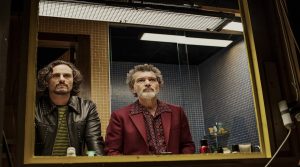
Dolor y gloria (English title: Pain and Glory)
It is a 2019 Spanish drama film directed and written by Pedro Almodóvar. It stars Antonio Banderas, Asier Etxeandia, Penélope Cruz, Julieta Serrano and Leonardo Sbaraglia. The film narrates a series of reencounters of Salvador Mallo, a film director in his decline. Some of these reencounters are physical, some others are remembered: his childhood in the 1960s, when he emigrated together with his family to Paterna in search of prosperity, the first desire, his first adult love in Madrid in the 1980s, the pain of the breakup of this relationship, writing as a therapy to forget, the premature discovery of cinema, facing the impossibility of continuing filming, etc.
In cinemas across the UK.

La casa de papel (English title: Money Heist)
A criminal mastermind who goes by «The Professor» has a plan to pull off the biggest heist in recorded history — to print billions of euros in the Royal Mint of Spain. To help him carry out the ambitious plan, he recruits eight people with certain abilities and who have nothing to lose. The group of thieves take hostages to aid in their negotiations with the authorities, who strategize to come up with a way to capture The Professor. As more time elapses, the robbers prepare for a showdown with the police.
Watch it on Netflix

Elisa y Marcela (English title: Elisa & Marcela)
It is a 2019 Spanish biographical romantic drama film directed by Isabel Coixet. Starring Natalia de Molina and Greta Fernández, the film tells the story of Elisa Sánchez Loriga and Marcela Gracia Ibeas, two women who passed as a heterosexual couple in order to marry in 1901 at Church of Saint George in A Coruña becoming the first same-sex matrimony recorded in Spain.
Watch it on Netflix

Las chicas del cable (English title: Cable Girls)
It is a Spanish period drama web television series. It stars Ana Fernández, Nadia de Santiago, Blanca Suárez and Maggie Civantos. In 1928, a modern telecommunications company begins to operate in Madrid. The series tells the turn in life that four young women take when they start working for this company. The four of them feel attached in different ways, to their families, their partners, or their memories. Part of the focus of the show is the hardships working women faced in the 1920s.
Watch it on Netflix

El ministerio del tiempo (English title: The Ministry of Time)
It is a Spanish fantasy television series created by Javier and Pablo Olivares. The series follows the exploits of a patrol of the fictional Ministry of Time, which deals with incidents caused by time travel.
Watch it on Netflix

La casa de las Flores (English title: The House of Flowers)
It is a Mexican comedy-drama web television series created by Manolo Caro. It depicts a dysfunctional upper-class Mexican family that owns a prestigious flower shop
Watch it on Netflix

Cuéntame cómo pasó (English title: Remember When)
It is a Spanish television drama series which has been broadcast on La 1 of Televisión Española since 2001. It is the longest running prime-time series in the history of television in Spain.
Watch it on A la Carta-RTVE
Spanish Becomes Most Popular Foreign Language at A Level
Spanish became the most popular foreign language at A Level with entries overtaking French for the first time, according to the Joint Council for Qualifications.
For the first time, Spanish entries overtook those for French, making it the most popular foreign language. Spanish entries increased by 4.5% to 8,625 and French decreased by 4.1% to 8,355. German entries remained level.
Entries for French, German and Spanish combined, have levelled off, reversing the decline in recent years against the backdrop of a 2.9% decrease in the size of the 18-year old population.
Ignacio Peyro, director of Instituto Cervantes, the official Spanish language and cultural centre said there had been concern in recent years about students taking foreign languages at GCSE and A-level.
But he added: “For us, of course it’s very positive that Spanish is growing and I think that it is in a global country like the UK, there’s a growing perception that the Spanish-speaking world is becoming more important in terms of demography, economy, trade, culture and so on.
“Who would have thought that 20 or 30 years ago that this was going to happen?” Mr Peyro said, pointing out that at that time, other languages such as French were more commonly taught.
“Spanish was in a very different place at that time.”
Mr Peyro also said it was “good to study any foreign language, better than none”.
“I hope that all foreign languages will soon be on the rise again in Britain,” he added.
More information: Spanish Becomes Most Popular Foreign Language, Press Association
Spanish courses Autumn 2019 – Cursos de español otoño 2019
New Spanish courses starting now!
Instituto Cervantes is the official Spanish Language centre. In London we run Spanish courses for all levels, from complete beginners to proficiency, aimed at developing the students’ ability to understand, speak, read and write in Spanish. Our experienced native Spanish teachers are university qualified and have trained specifically to teach Spanish as a foreign language using the most up-to-date teaching methods.
Our Spanish courses are offered during the day and in the evening Monday to Friday and on weekends on Saturday and Sunday. They are generally 30 hours long and can be taken in one week (crash courses), two weeks (intensive courses), 5 or 6 weeks (semi-intensive) or 10 / 12 weeks (regular courses).
We also offer a wide range of more specific Spanish courses such as online courses; courses to prepare for the DELE Spanish official exams, GCSE and A levels; business Spanish, translation, literature, history, psychology, general conversation, Spanish for children and teacher training courses. Other courses and private and corporate tuition are available on demand.
More information here
Please note that our Enrolment Office will be opened as follows from 19th July to 20th September 2019, both included:
- Monday to Thursday: 9.30 to 18.00
- Friday: 9.30 to 14.30
- Saturday: 10.00 to 14.00
- Sunday: Closed
Nuevos cursos regulares e intensivos, matrícula abierta.
El Instituto Cervantes es el centro oficial de referencia para aprender español en Londres. Todos nuestros profesores, cuya lengua materna es el español, poseen al menos un título universitario, se han formado específicamente para enseñar español como lengua extranjera utilizando la metodología más actual y cuentan con una amplia experiencia docente.
Ofrecemos cursos de todos los niveles, desde inicial absoluto hasta perfeccionamiento, diseñados con el objetivo de que los alumnos desarrollen su capacidad para hablar, entender, leer y escribir en español. Los cursos se imparten durante el día, por la tarde-noche y los fines de semana sábados y domingos. Nuestros cursos generales de español tienen una duración de 30 horas y pueden realizarse en una semana (cursos crash), dos semanas (intensivos), 5 o 6 semanas (semiintensivos) o 10/12 semanas (cursos regulares).
Además de cursos generales de español, ofrecemos una amplia gama de cursos específicos, como cursos de preparación de exámenes oficiales (DELE, GCSE, AS y A2 levels), traducción, español de negocios, lengua y cultura (conversación general, literatura, cine, historia), cursos de español online, cursos para niños y cursos de formación de profesores. También ofrecemos cursos a la carta y clases para particulares y en empresas.
Más información aquí
La secretaría permanecerá abierta desde el 19 de julio al 20 de septiembre de 2019, ambos incluidos, en el siguiente horario:
- Lunes a jueves: 9.30 – 18.00
- Viernes: 9.30 – 14.30
- Sábado: 10.00 – 14.00
- Domingo: cerrado

